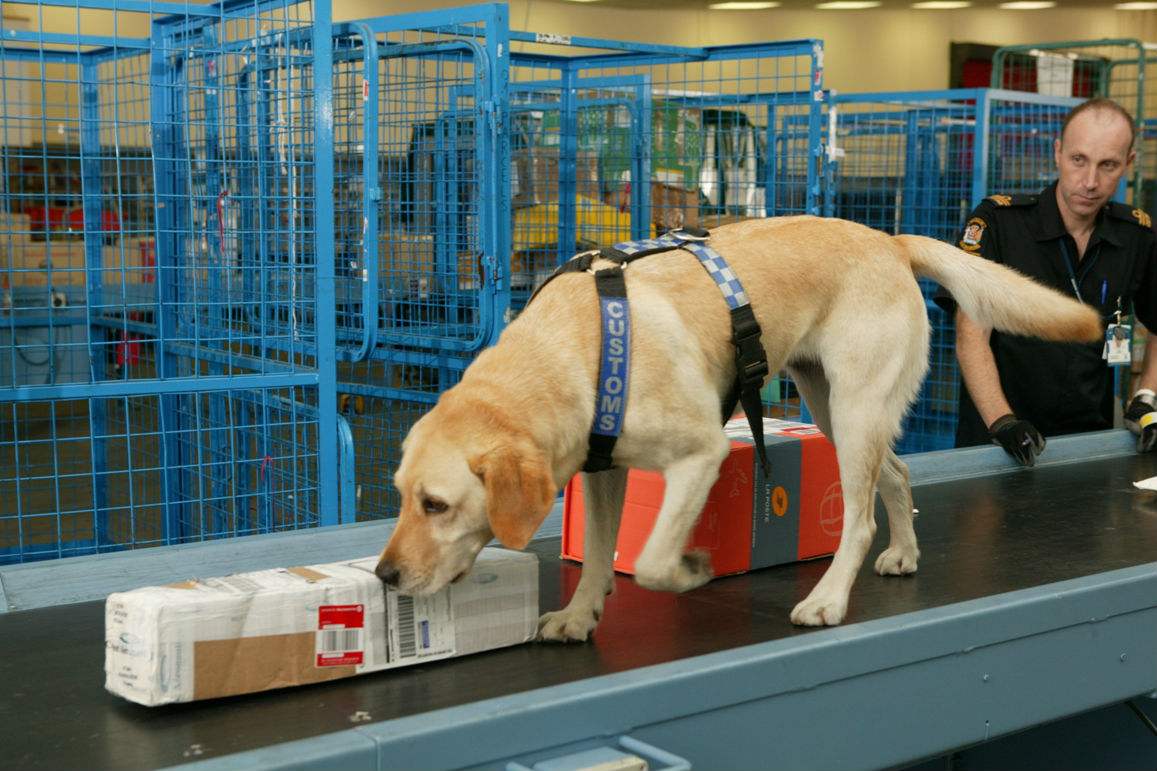(单词翻译:单击)
听力文本
This is Scientific American — 60-Second Science. I'm Christopher Intagliata.
Old Yeller was a great smeller. Dogs in general have superior smelling abilities. They detect dead bodies, illegal drugs and explosives—even cancer. But dogs don't just have great olfactory gear. Another reason they're amazing chemical detectors? [sniffing sound]... is the sniff.
"And it turns out almost every breed of dog does this at 5 Hz. Five times a second." Matthew Staymates, a mechanical engineer and fluid dynamicist at the National Institute of Standards and Technology. Sniffing, he says, is really a two-part process. "Inspiration, expiration, right? Inhale, exhale, inhale, exhale." That second part, the exhale, is key.
"So when the dog is actively sampling or sniffing on the ground, there is a turbulent air jet that exits each nostril during the exhale phase. Just like when you and I exhale there's an air jet that comes out of our nostrils. But the dog is down on the ground and those air jets are vectored down and toward its rear. And in the world of fluid dynamics, if I pulse an air jet in one direction I basically pull air with it." So the dog is creating a pressure differential that effectively pulls new scents toward its nose.

Staymates and his colleagues discovered that effect using a 3-D–printed model of a Labrador retriever's nose, which they tested with fluid dynamics equipment. They then outfitted a commercial vapor detector with sniffing nostrils, inspired by the dog nose. And they found that the actively sniffing detector was 16 times better at picking up the scent of explosives, compared to just continuously drawing in air—whick is the usual method. The results are in the journal Scientific Reports.
Staymates says he hopes next-generation sensors take sniffing seriously. "There's nanosensors out there that can detect very, very small amounts of materials. One of the things that's been overlooked: is how do you get the molecules of interest to the detector, right? So you can have the most sophisticated detector in the world, but unless you can get material to it, it's not very useful." Adding a sniffer though…could be just the thing to make those detectors more dogged.
Thanks for listening for Scientific American — 60-Second Science Science. I'm Christopher Intagliata.
参考译文
这里是科学美国人——60秒科学。我是克里斯托弗·因塔利亚塔。
老黄狗的嗅觉非常灵敏。一般而言,狗具有优越的嗅觉。它们可以发现尸体、非法药物、炸药、甚至是癌症。但是狗狗们并不仅仅拥有强大的嗅觉器官。另外一个原因,它们还是神奇的“化学探测器”?(嗅的声音)那就是嗅。
“事实表明,几乎每个品种的狗吸气的频率都是5赫兹。即一秒钟5次。”马修·斯特梅茨是美国国家标准与技术研究院的机械工程师和流体动力学家。他表示,嗅实际上有两个过程。“吸气和呼气,对吧?吸气,呼气,吸气,呼气。”第二部分才是关键,也就是呼气。
“当狗狗积极地在地上闻东西或嗅东西时,它在呼气的过程中每个皮孔都会喷出紊流空气。就像我们呼气的时候,我们的鼻孔也会有气流喷出。但是狗狗是附身嗅地面,呼出的空气流会反冲向自己的呼吸器官。在流体动力学领域,如果我向一个方向呼出空气流,其实我也是在拉动空气。”所以,狗狗是在制造一种压力差,可以有效地使鼻子嗅到新的气味。
斯特梅茨和同事们利用拉布拉多猎犬鼻子的3D打印模型对这种效果进行了研究,他们在测试时使用了检测流体动力学设备。受到狗鼻子的启发,他们在商业蒸汽探测器上也安装了“嗅觉”装置。他们发现,与只是持续吸入气流的通常作法相比,这种嗅觉探测器在识别炸药气味上的表现要优秀16倍。该研究结果发表在《科学报告》期刊上。
斯特梅茨表示,希望他下一代传感器可以认真考虑嗅觉装置。“有的纳米传感器可以检测到极其少量的材料。但有一点被人们所忽视:如何获得分子探测器?这样你就可以拥有世界上最先进的探测装置,不过如果你没有材料,这个装置或许不太实用。”只需添加一个嗅觉装置,就可以让那些感应器更加灵敏。
谢谢大家收听科学美国人——60秒科学。我是克里斯托弗·因塔利亚塔
译文为可可英语翻译,未经授权请勿转载!
重点讲解
重点讲解:
1. turn out 原来是;结果发现;
例句:It will turn out to be right in the end.
这件事情在最后会被证明是正确的。
2. pick up 发现,找到,识别(特点或模式);
例句:Consumers in Europe are slow to pick up trends in the use of information technology.
欧洲消费者在辨别信息技术应用的潮流上表现迟缓。
3. compared to 与…相比;和…比起来;
例句:This problem was insignificant compared to others she faced.
这一问题与她面临的其他问题比较起来算不得什么。
4. take sth. seriously 认真对待;把…看得很重要;
例句:Please take this matter seriously if you want to get out of this trap.
如果你想从陷阱里出去,请认真考虑这件事。


